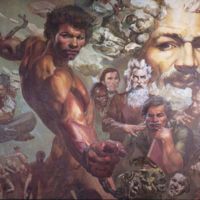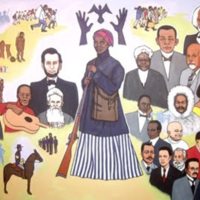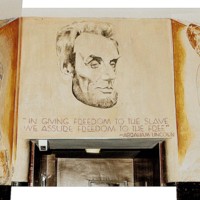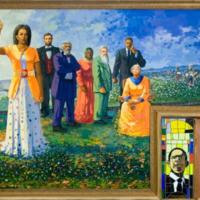![Diego Rivera, Panel V of Portrait of America, New Workers School, New York City, 1933 [destroyed] (2).jpg Diego Rivera, Panel V of Portrait of America, New Workers School, New York City, 1933 [destroyed] (2).jpg](https://486312.frmmmguz.asia/files/square_thumbnails/5a3ba3415ccc36fadeb19c4d16fa1879.jpg)
Portrait of America
In 1933, the Mexican muralist Diego Rivera painted a 21-panel mural titled Portraits of America. Created for New York City’s New Workers School, the mural focused on issues of racial inequality and depicted the antislavery figures Frederick Douglass and John Brown, as well as shackled slaves - seen here in panel five of the mural. Rivera believed art was a weapon in the class struggle and frequently produced murals about revolution. Rivera, David Alfaro Siqueiros and José Clemente Orozco were the pioneers of the Mexican mural movement, and influenced mid-century African American muralists Hale Woodruff, John Biggers and Charles White.

Life and Times of Frederick Douglass
In 1972, artist LeRoy Foster created this mural for the Douglass Branch of the Detroit Public Library. The mural depicts a meeting between Frederick Douglass and John Brown that took place on March 12, 1859, seven months before Brown’s raid on Harper’s Ferry. The mural contains three likenesses of Douglass in various stages of his life – the most prominent being the shirtless figure in the centre of the mural. The second largest figure of Douglass portrays him with the leonine, statesmen persona that he embodied later in his life. Finally, the smallest Douglass likeness is the seated figure speaking with John Brown. This small scene marks a pivotal moment in Douglass' life. In 1859 he had to make the decision between fighting with Brown (embodying the chain-breaking version of himself in the mural), or surviving to become a political leader. Choosing not to take up arms at Harper's Ferry, an attack that led to the execution of Brown for treason, Douglass chose the elder statesman person - and lived to 1895.

From Africa to America
Wilfred R. Stroud created this seven-panel mural in 1988 to be installed on the first floor of the Tubman Museum. It remains a signature piece in the Museum’s collection today. When the mural was being created, Stroud expained: “The purpose of this mural is to present a visual history of the black man and woman from the earliest times in Africa to the present times in America. The panels focus attention upon the impact of outstanding persons, and events that made a change in the lives and conditions of black people in particular, and the world in general.” Stroud dedicated an entire panel to the topic of slavery. Harriet Tubman stands in the centre, holding a rifle and surrounded by other antislavery leaders: Sojourner Truth, Abraham Lincoln, Frederick Douglass and John Brown.
![John Weber, Wall of Choices, Christopher Settlement House, N Greenview Ave and W Altgeld St, Chicago 1970 [destroyed], detail.jpg John Weber, Wall of Choices, Christopher Settlement House, N Greenview Ave and W Altgeld St, Chicago 1970 [destroyed], detail.jpg](https://486312.frmmmguz.asia/files/square_thumbnails/9fc1c6430ac66c245ed40da9a8d9ad6c.jpg)
Wall of Choices
In 1970, John Pitman Weber of the Chicago Public Art Group created a mural on the wall of the Christopher Settlement House on the north side of Chicago. The mural faces a children’s playground in a predominantly white working-class area of the city and according to Weber, the neighbourhood’s anxiety regarding racial tensions in the community only emerged during the creation of the mural and related discussions with local residents. Working together, Weber and the local residents agreed that the racial concerns needed to be surfaced, and the mural would serve this purpose. It depicts narrative scenes across the wall, including daggers and guns held by both black and white individuals, black hands in handcuffs under the phrase “free all political prisoners,” (something that the Black Panther Party was pushing for in the 1960s and 1970s), and a black hand shaking a white hand under the faces of Frederick Douglass and the radical white abolitionist John Brown, who are both identified on the mural as Freedom Fighters. The mural had been destroyed by the late 20th century.

Seward Park Mural
In 1959 the Hungarian-American illustrator and muralist Hugo Gellert created the series Seward Park Housing Murals. The four-panel mural series depicts Thomas Jefferson, Abraham Lincoln, Franklin D. Roosevelt and Albert Einstein and was commissioned by the International Ladies Garment Workers Union. The Abraham Lincoln panel has an abolitionist section that features Frederick Douglass, John Brown, Harriet Tubman, Sojourner Truth and William Lloyd Garrison.The mural was threatened with destruction many times, including in 1996 when the building residents voted to become a private co-op. Individuals on the co-op board then voted to rid the lobby of the murals that they deemed racist, ugly, socialist or 'past their time.' But the building manager, Frank Durant, insisted on their preservation.

From Menelik I to Obama
Ethiopian artist Mekbib Gebertsadik put the abolitionist Frederick Douglass alongside President Lincoln, the abolitionist John Brown, Malcolm X, President Obama and Michelle Obama. Titling the mural From Menelik I to Obama, Gebertsadik also placeed Douglass on a timeline of diasporic history that starts with Menelik I, the first Solomonic Emperor of Ethiopia in 950 BC, to President Barack Obama, the first African American president. The mural is a few blocks away from the White House at the Gospel Rescue Ministries homeless shelter, acting as a symbol of hope for those passing through. “Primarily, the clients we serve are African American and [the mural is] an inspiration to our clients of being able to dream” explains Earl Murray, Associate Director for Development and Marketing for Gospel Rescue Ministries.